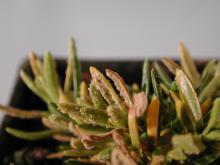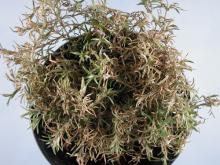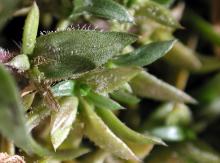Cause Downy mildew on phlox is caused by the fungus-like organism Peronospora phlogina. Although not formally reported from the Pacific Northwest, it has been found by both the OSU and WSU Plant Clinics. This fungus is known to infect only plants in the phlox family Polemoniaceae, such as the genera Collomia sp., Gilia sp., Microsteris sp., Navarretia sp., and Phlox sp. Some of these plants are native to the Western United States and may be hosts for the disease. Cool, wet conditions favor infection and sporangia development. Sporangia are windborne spores that are easily disseminated throughout an area such as a greenhouse.
Symptoms Irregular yellow areas on the leaf and slow-growing, slightly distorted stems are the most common symptoms. White-to-grayish fungal growth on either the lower or upper surfaces of leaves and on newer portions of stem indicate downy mildew. It sometimes is confused with powdery mildew.
Cultural control It is easier to control if spotted before it is widespread.
- Scout plants carefully for symptoms of the disease especially the undersides of leaves and any stock plants or plants held over from the previous year.
- Immediately remove and discard infected plants.
- Heat and vent greenhouses late in the day to lower relative humidity at night.
- Maintain adequate fertility.
Chemical control Protective applications are important, particularly when the disease has been a problem in previous years. Once the disease is detected, apply two (2) to three (3) times at the closest intervals allowed. Close intervals may be necessary when environmental parameters cannot be manipulated to avoid conditions that favor disease. Rotate between chemicals to reduce the possibility the fungus will develop resistance to fungicides.
- CuPRO 5000 at 1.5 to 2 lb/A. Group M1 fungicide. 48-hr reentry.
- Daconil Weather Stik at 1.38 pints/100 gal. Group M5 fungicide. 12-hr reentry.
- Heritage at 2 to 4 oz/100 gal water plus a non-silicone-based wetter sticker. Group 11 fungicide. 4-hr reentry.
- Insignia SC at 3 to 6 fl oz/100 gal water. Do not use with organosilicate-based adjuvants. Use preventively only. Group 11 fungicide. 12-hr reentry.
- Mefenoxam 2 AQ at 0.49 to 0.98 fl oz/100 gal water plus another fungicide with a different mode of action. Group 4 fungicide. 48-hr reentry.
- Micora at 4 to 8 fl oz/100 gal water. Group 40 fungicide. 4-hr reentry.
- Nu-Cop 50 DF at 1 lb/100 gal water. Group M1 fungicide. 48-hr reentry. O
- Monterey Garden Phos at 0.5 to 1.1 fl oz/gal water as a foliar spray. Also labeled for soil drench, see label for details. Group P7 fungicide. H
- OxiPhos at 1.3 to 4 quarts/100 gal water as a foliar spray. Group P7 fungicide. 4-hr reentry.
- Protect DF at 1 to 2 lb/100 gal water plus a spreader-sticker. Group M3 fungicide. 24-hr reentry.
- Phyton 27 at 1.5 to 3 fl oz/10 gal water. Group M1 fungicide. 48-hr reentry.
- Segovis at 0.6 to 3.2 fl oz/100 gal water plus another fungicide. Group 49 fungicide. 4-hr reentry.
- Zonix at 45 to 76 fl oz/100 gal water. Can be sprayed on crop or injected into irrigation system. Short residual so may have to be used frequently for adequate results. 4-hr reentry.
Reference Daughtrey, M.L., Wick, R.L., and Peterson, J.L. 1995. Compendium of Flowering Potted Plant Diseases. St. Paul, MN: APS Press.




